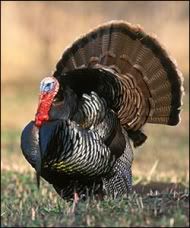 Physical Description
Physical DescriptionChestnut brown-tipped tail coverts (smaller feathers which cover up larger ones) and dark-buff or chocolate-brown tail tips characterize the most abundant and most widely hunted turkey, the Eastern Wild Turkey. The tom turkey’s breast feathers are tipped in black, while other body feathers are colored with copper or bronze metallic iridescence. The primary wing feathers have white and black bars that extend to the feather shaft, while the secondary wing feathers mainly have prominent white bars. This results in a white triangular area on each side of the back when the wings are folded backward. Hens are browner with less brilliant iridescence and the breast feathers are tipped in buff or chestnut. The Eastern tom and hen generally can grow up to four feet in height.
Average Weight Range
The mature Eastern Wild Turkey weighs from eight to 25 pounds, with some individual toms topping 30 pounds.
Reproduction
Breeding occurs during the spring and summer months, usually starting in late February or early March in southern states. Breeding won’t occur until April in northern states such as Vermont and other northernmost areas. The cycle is complete with the hatching of poults in summer. The increase of daylight hours in spring triggers hormonal changes. Males exhibit both gobbling and strutting to attract females. Gobbling attracts the hen to the male with specific mating calls. The male will then court the female by strutting back and forth. If the gobbler is successful, the female will crouch to signal the male to begin copulation. The first peak time for gobbling occurs at the beginning of breeding season when gobblers are searching for hens. The second peak begins a few weeks later, when most hens begin incubation. Gobblers usually mate with several hens, and it is generally the adult males who do most of the mating. Hens lay anywhere from 8 to 12 eggs per clutch, averaging about 28 days for incubation.
Food Usage/Selection
Wild turkeys are omnivores, eating a variety of plant and animal matter wherever and whenever available. Poults eat large quantities of insects and other animal matter to get needed protein for development. As turkeys age, plant matter becomes the primary food source. About 90 percent of the mature turkey’s diet comes from plants, including green foliage of grasses, vines, forbs, acorns, buds, seeds, various fruits and waste grain from agricultural crops.
Range
The Eastern Wild Turkey inhabits the eastern half of the U.S., and can be found in hardwood and mixed forests from New England and southern Canada to northern Florida and west to Texas, Missouri, Kansas, Iowa, and Minnesota, however, it has been transplanted in California, Oregon, and Washington and other areas west of the Rocky Mountains.
Habitat
The Eastern turkey, which has adapted to many habitats, utilizes both hardwood and softwood forests, open pastures, and agricultural fields.
Common Hunting Methods
The shotgun, bow and arrow, and black powder are all used to hunt turkey. Rifles are also allowed in some states. Hunters use a wide variety of calls to attract turkeys within shooting range. Calling has become so popular that contests are held each year so experts and novices alike can fine-tune their skills.
Hunting Challenges/Values
With their excellent eyesight and well-developed sense of hearing, turkeys are constantly aware of their surroundings. The turkey can sometimes outsmart hunters who use decoys as they become more and more sensitized to their presence. Wild turkeys are very good to eat and can be smoked, fried or baked. Many hunters proudly display their colorful capes, beards or full-bodied mounts.
Interesting Tidbits
Turkeys will answer thunder from an approaching storm with a shock gobble.
Turkey hunting is one of the most popular forms of hunting.
Hens produce droppings in shapes like a mound, and the gobbler’s droppings are in a straight line or resemble the letter “J.”
Read about other Turkey subspecies:
Eastern Wild Turkey
Gould's Turkey
Merriam's Turkey
Ocellated Turkey
Osceola/Florida Turkey
Rio Grande Turkey

No comments:
Post a Comment